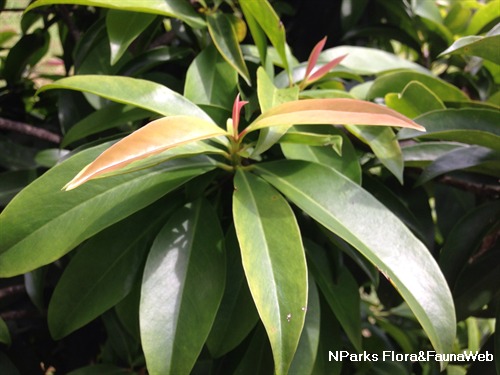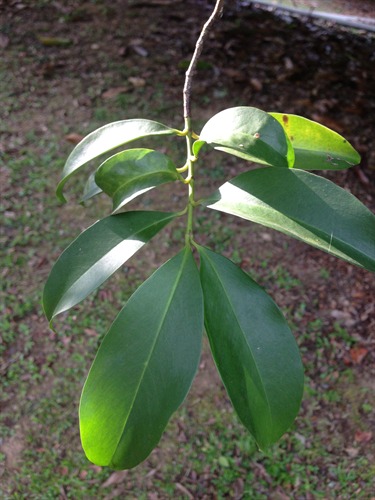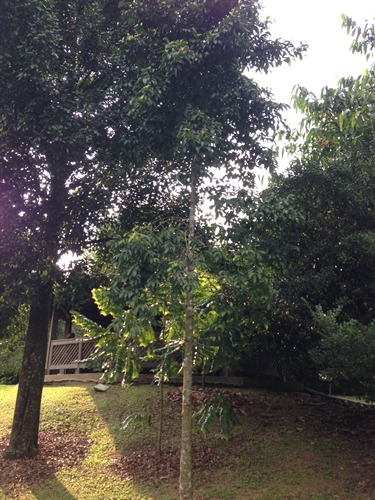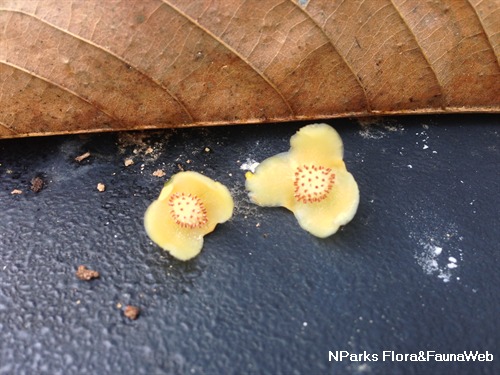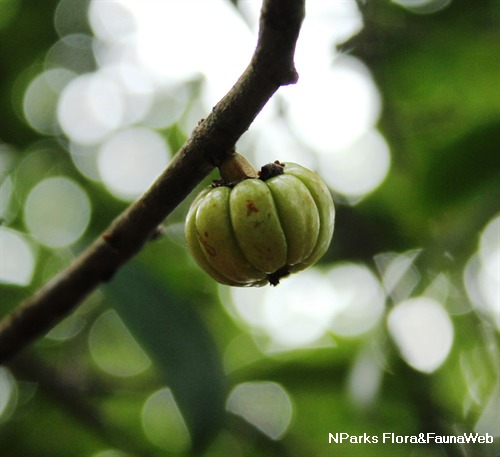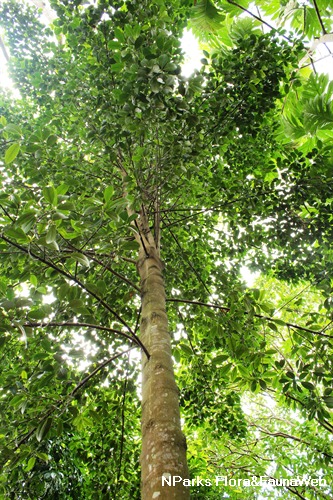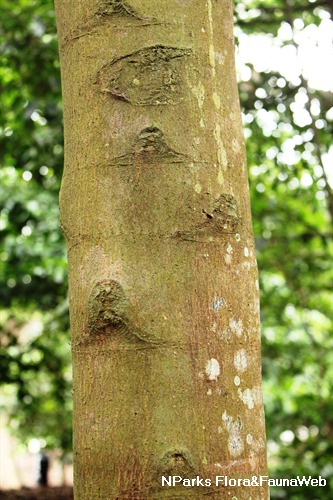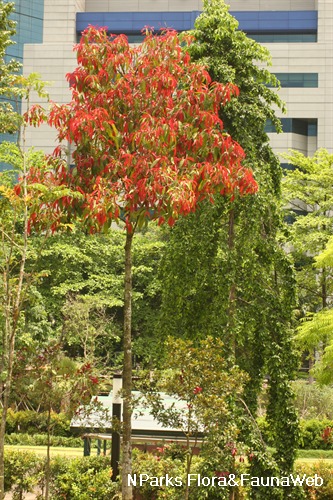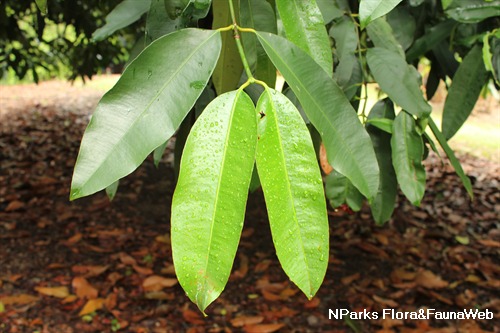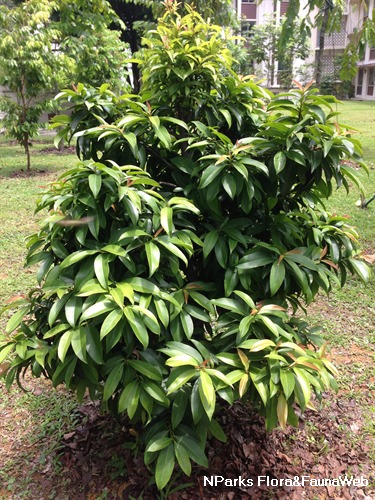
Back
Garcinia gummi-gutta (L.) Robs.
| Family Name: | Clusiaceae (Guttiferae) |
| Synonyms: | Garcinia quaesita, Garcinia cambogia |
| Common Name: | Gambooge, Malabar Tamarind |
Name
Classifications and Characteristics
| Plant Division | Angiosperms (Flowering Seed Plants) |
|---|---|
| Plant Growth Form | Tree (Medium (16m-30m)) |
| Lifespan (in Singapore) | Perennial |
| Mode of Nutrition | Autotrophic |
| Plant Shape | Irregular |
| Maximum Height | 5 m to 20 m |
Biogeography
| Native Distribution | India and Sri Lanka |
|---|---|
| Native Habitat | Terrestrial (Primary Rainforest, Riverine) |
| Preferred Climate Zone | Tropical |
| Local Conservation Status | Non-native |
Description and Ethnobotany
| Growth Form | It is a small to medium sized tree, 5 - 20m tall. |
|---|---|
| Foliage | Its oppositely-arranged, stalked leaves are elliptic to obovate in shape, 13-18 cm long and 4-8 cm long. |
| Flowers | The plant is dioecious, with male and female flowers borne separately on different plants. Its stalked flowers are borne singly or in clusters of 4-20, about 3 cm wide. Petals are red or sometimes, yellow. |
| Fruit | Its ovoid fruits are about 5cm in diameter, ripening from green to yellow or red. |
| Habitat | It grows in lowland forests. |
| Associated Fauna | Its flowers are pollinated by insects, and its fruits are probably eaten by small mammals. |
| Ethnobotanical Uses | Food (Herb or Spice) (Fruit or Vegetable): The fruits are edible and used to flavour fish and prawns. The dried seeds are made into a paste. The fruit juice is also for weight loss. Medicinal: A decoction of the plant is used to treat rheumatism and bowel problems. Timber & Products: Its wood is used as for construction and making furniture. |
Landscaping Features
| Landscaping | It is suitable for planting in parks and streetscapes for its attractive form and for providing shade. |
|---|---|
| Desirable Plant Features | Ornamental Form |
| Landscape Uses | General, Suitable for Roadsides, Parks & Gardens, Riverine, Shade Providing Tree / Palm |
Fauna, Pollination and Dispersal
| Pollination Method(s) | Biotic (Fauna) |
|---|---|
| Seed or Spore Dispersal | Biotic (Fauna) |
Plant Care and Propagation
| Light Preference | Full Sun |
|---|---|
| Water Preference | Moderate Water |
| Plant Growth Rate | Moderate |
| Rootzone Tolerance | Moist Soils, Waterlogged Soils (Drains Site), Fertile Loamy Soils |
| Propagation Method | Seed |
Foliar
| Foliage Retention | Evergreen |
|---|---|
| Mature Foliage Colour(s) | Green |
| Mature Foliage Texture(s) | Leathery |
| Foliar Type | Simple / Unifoliate |
| Foliar Arrangement Along Stem | Opposite |
| Foliar Attachment to Stem | Petiolate |
| Foliar Shape(s) | Non-Palm Foliage (Obovate, Elliptical) |
| Foliar Venation | Pinnate / Net |
| Foliar Margin | Entire |
Floral (Angiosperm)
| Flower & Plant Sexuality | Unisexual Flowers , Dioecious |
| Flower Colour(s) | Cream / Off-White, Red, Yellow / Golden |
|---|
| Flower Grouping | Solitary, Cluster / Inflorescence |
| Flower Location | Axillary |
| Flower Symmetry | Radial |
Fruit, Seed and Spore
| Mature Fruit Colour(s) | Red, Yellow / Golden |
|---|---|
| Fruit Classification | Simple Fruit |
| Fruit Type | Fleshy Fruit , Non-Accessory Fruit |
Image Repository
Others
| Master ID | 29899 |
|---|---|
| Species ID | 4208 |
| Flora Disclaimer | The information in this website has been compiled from reliable sources, such as reference works on medicinal plants. It is not a substitute for medical advice or treatment and NParks does not purport to provide any medical advice. Readers should always consult his/her physician before using or consuming a plant for medicinal purposes. |

